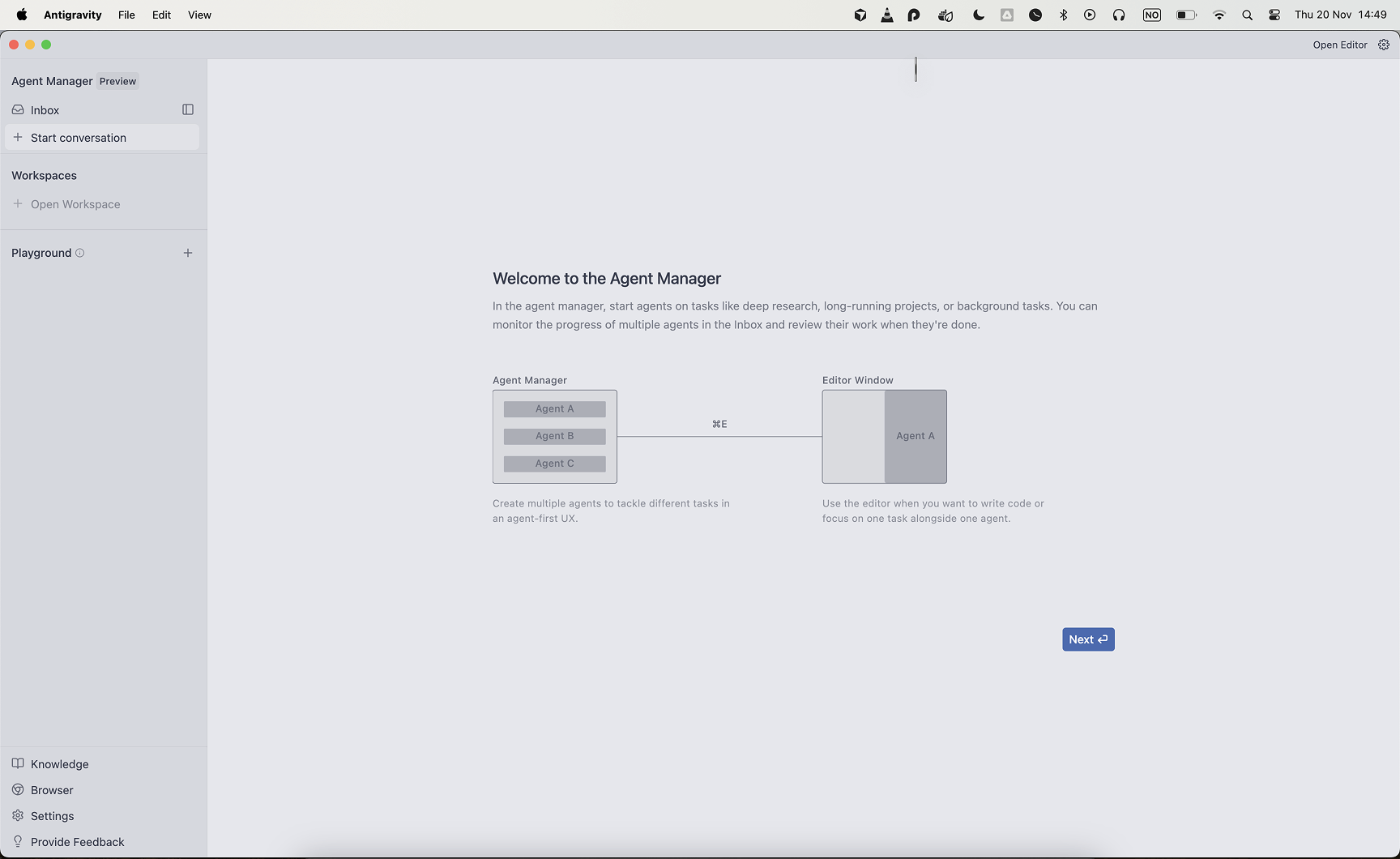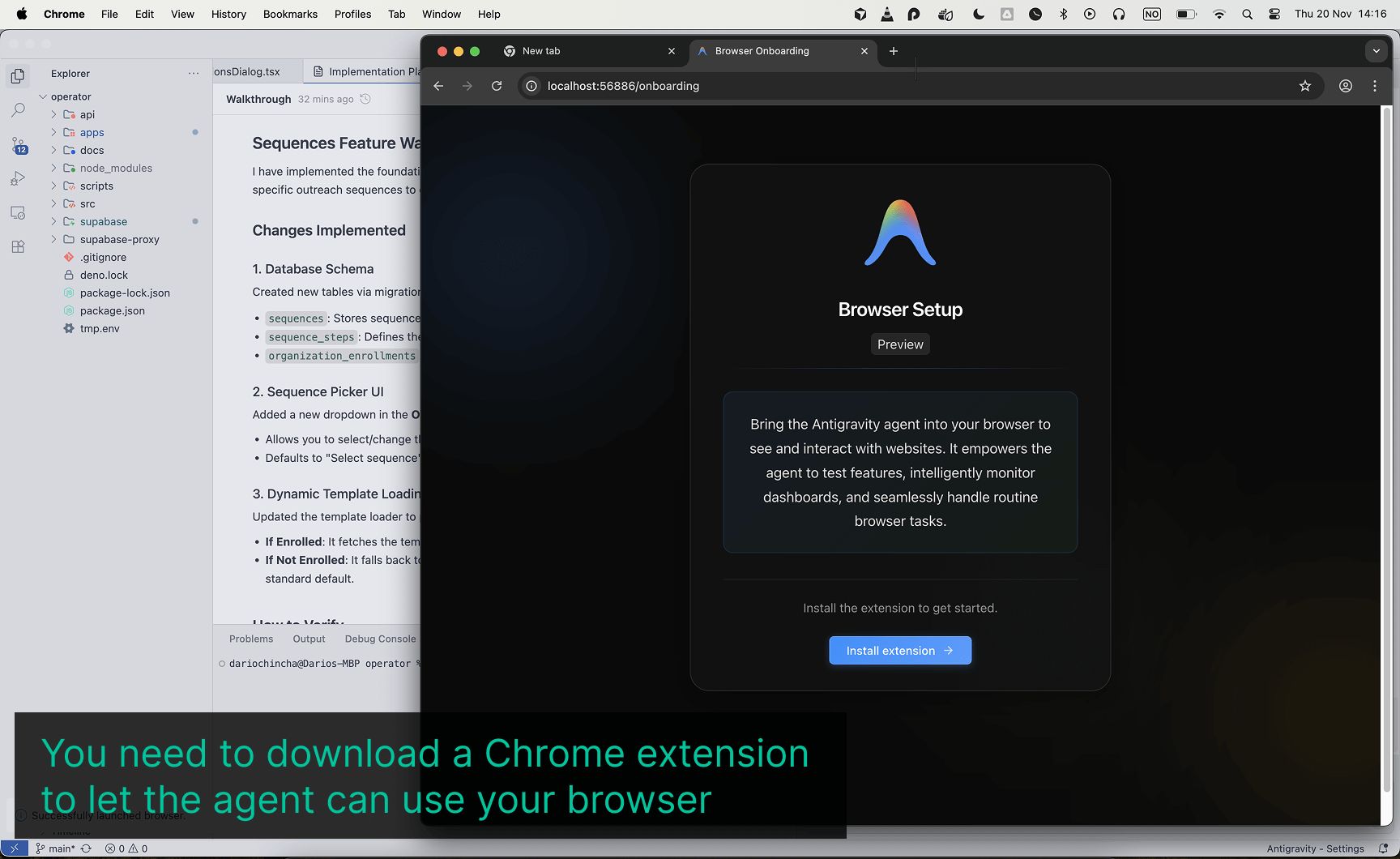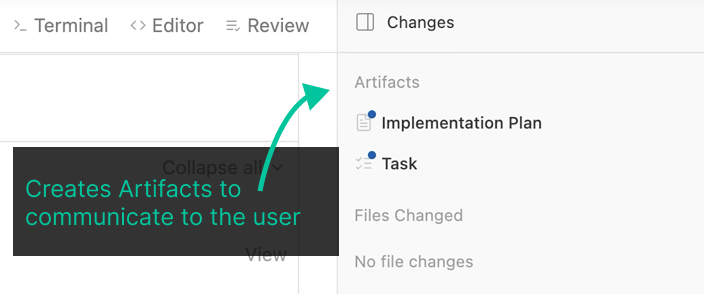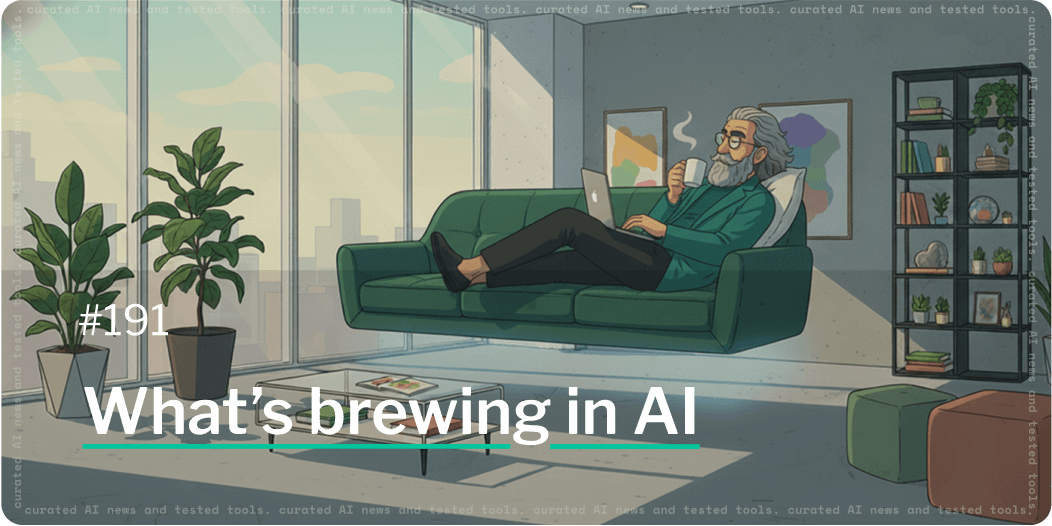- What's brewing in AI
- Posts
- 🧙🏼 I tested Antigravity: Google’s agentic IDE
🧙🏼 I tested Antigravity: Google’s agentic IDE
The vibe coding force is strong with this one. But is it stronger than Cursor?
I tested Antigravity: Google’s agentic IDE
The vibe coding force is strong with this one. But is it stronger than Cursor?
Was this email forwarded to you? Sign up here.

TLDR: I’ve tested Google’s new AI code editor, Antigravity. It’s joining my stack, but I’ll also still be using Cursor.
When I saw that Google launched Antigravity this week, alongside Gemini 3 Pro, I knew I had to test it.
Antigravity is an agent-first coding Integrated Development Environment (IDE), similar to Cursor, Windsurf, etc. Its unique features immediately spoke to me: a native browser integration, an agent view and a visual feedback system (Artifacts). Plus, I also wanted to test Gemini 3 Pro for coding.
This is my favourite kind of review to write. I'm testing Antigravity to find out if it's a worthwhile addition to my deliberately minimal set of tools I use daily.
Quick context so you understand my frame of reference. I'm not a pro developer. I have previous experience building web apps with no-code, and a background in data & analysis. I’ve been vibe coding for the last six months using Cursor, Claude Code and Codex. So far I've built three internal tools I actually use daily. Google is positioning Antigravity primarily to professional engineers, and I found using it to be the same level of difficulty as using Cursor, maybe slightly easier to start with thanks to its pure agent view1.
I tested Antigravity over 3 days while building a sales tool for myself.

Pictured: Google’s Antigravity in dark mode, and my dark roast antigravity
Antigravity is divided into two main surfaces you can switch between: a traditional editor mode where you see all your code, and an agent manager mode where you see only agents.
Agent manager makes it easy to run multiple agents simultaneously (maybe too easy). I found it useful, but not game-changing.
It gives you a sidebar fully dedicated to orchestrating agents in parallel on different tasks, and a unified inbox, where the agents ping you when they’re done with their task or need your input.

As I was coding on a main task, I ran into little side-tasks that needed to be done. Previously in such situations, I’ve kept a Note with upcoming small tasks (e.g. fix z-index of this dropdown) to avoid losing focus of the main task.
The beauty of the agent manager in Antigravity is that I can see all my workspaces and ongoing conversations in a sidebar. Instead of having notes of upcoming tasks, I just delegate them to separate agents. Separate agents who, when they’re done, send me a pleasant notification in my unified inbox.
A couple of times I gave the right instructions to the wrong agent—now there’s a fine recipe for confusion. A clearer visual distinction between agents, like colour themes for agents, could’ve helped.
Juggling multiple agents certainly made me feel productive and busy, but I’m not convinced the project actually moved much faster because my instructions weren’t as well thought through as when I focused on a single task.
For this reason, I’ll probably stick to managing 1-2 agents at a time.
IN PARTNERSHIP WITH DELVE

This Thanksgiving, we’re serving up more than turkey, we’re helping you stuff your pipeline.
Get $1,500 off compliance + a $500 Visa gift card when you become SOC 2 compliant with Delve before November 27th.
Because while your sales team is feasting, your deals shouldn’t be starving.
Delve’s AI agents handle all the heavy lifting: automating your SOC 2 evidence, risk checks, and audits in record time. No spreadsheets. No manual madness. Just compliance done fast, so you can focus on your next big win.The results speak for themselves:
Lovable → SOC 2 in 20 hours.
Wisprflow → Signed Mercury & Superhuman in 1mo
11x → $1.2M ARR unlocked.
Use code THANKSGIVING before 11/27 at 11:59 PM PST.
I found the most significant advantage of Antigravity over Cursor to be its ability to see and control the browser.

Antigravity can operate a browser, get technical info in real-time, capture screenshots and screen recordings. It can debug, verify and document the work it’s doing.
There’s been versions of browser integrations in other IDEs, but this is by far the best one I’ve seen so far.

The browser lights up in a blue frame when Antigravity takes control
In the example pictured above, I had styling issues with a dropdown, and the agent wasn’t able to solve it with my text instructions. I told it to use the browser and it worked almost immediately. Giving AI visual feedback is often faster and more accurate than describing the problem in text2.
What’s great for all the non-dev, vibe coding heroes out there is that not only does the agent use the browser to test and debug, it also automatically saves all the screenshots and screen recordings as documentation.
I can review exactly what it did in a visual manner which is handy exactly because, as it happens, I don’t understand all the code.

Artifacts are things like task lists, implementation plans, walkthroughs, screenshots, and browser recordings
Artifacts is another feature I found very useful in making the communication between the user and agents more efficient.
Antigravity with Gemini 3 Pro plans out and documents its work in the most structured and detailed way I’ve seen so far.
It does this by creating Artifacts: implementation plans, tasks lists, walkthroughs. They consist of a combination of plain text, images and the screen recordings it did with the browser. They make it a whole lot more clear to me what the AI is going to be doing and what has been done.

But Artifacts work just as well the other way, from user to agent.
I can simply mark text or areas of an image/screenshot and leave feedback for the Agent directly inline in the Artifact (they took this inspiration from Google Doc I think).
That makes it easy to give highly structured and pointed feedback to the agent, with less prompting.
Other things I liked
Antigravity elevate a few more things in the AI coding sphere:
Generate commit message. This was a small but time-saving feature I spotted in Antigravity. There’s a 1-click button to summarise your changes in a commit message before you push/save to GitHub. Cursor does have something similar, but the messages here were very precise and succinct.

MCP integration that’s dead simple. There's an integrated MCP store with popular servers as 1-click installs. Setting up my Supabase MCP took literally two clicks and no restart needed. The easiest MCP setup I've tried so far.
Review policies that give you control. It’s easy to set how much autonomy agents have, separately, for implementing code and for using the terminal.

At first I didn't understand there was this concept of 'review policies'. I had mine set on Agent Decides, and so even in Planning mode the agent would just go ahead and change up all my code. I’ve now set it to request review again, and it’s behaving nicely.
A UI that’s actually quite polished. For being a v1, Antigravity’s UI comes across as well made. Drag-and-drop for images is lightning fast and non-glitchy (this is annoying about Codex). The formatting in the agent chat is excellent; high readability with strong text and table formatting, on par with Cursor's native agent.
Design mockups with Nano Banana. You can generate interface mockups directly within Antigravity and leave visual feedback directly on the image. It also has access to the brand-new Nano Banana Pro. Very handy for quick mockups.
Generous rate limits on free tier. I tested Antigravity entirely on the free tier, which gave me ≈2 hours of active usage with Gemini 3 Pro at a time before hitting rate limits. That’s actually quite decent for a free plan.
What could be better
There were a few less uplifting aspects of Antigravity, offering a slight downward pull on my overall impression.
No access to OpenAI's best models. Antigravity supports Gemini 3 Pro, Claude Sonnet 4.5, and the open-source GPT-OSS 120B model. But you can't use OpenAI's GPT-5.1 or Codex, which is a bummer.

and that warning sign means I’ve been rate limited ⏱️
Launch week growing pains. The agent frequently terminated with "model provider overload" errors. Guess this will stabilise soon.

Browser integration needs nudging. The agent often doesn't realise it can use the browser automatically. It'll ask me to check something, and I have to reply "you can do it yourself." Would be awesome if it was more automatic.
The agent gets lazy sometimes. Occasionally the agent says "I'm working on this now" and then... doesn't. I’ve seen the same a lot with Claude Code, though it happens less in Codex.
The verdict: Cursor is getting a run for its money
Testing Antigravity was by far a net positive experience for me.
The three key new features it brings to the table within the agentic IDE space—agent manager, tight browser integration, Artifacts—actually make the experience of coding with AI more delightful.
If you’re using Cursor and find these feature appealing, Antigravity is definitely worth testing.
For me, it could easily replace Cursor as an IDE, but it probably won’t as long as it doesn’t have access to OpenAI’s models, and the Codex IDE Extension remains unavailable for Antigravity.
I see myself using Antigravity/Gemini 3 Pro for tasks where browser feedback is highly advantageous, while leaning on Cursor/Codex (especially the new GPT-5.1-Codex-Max model) for the most long-running and complex tasks.
Gemini 3 Pro and Codex are the best coding models I’ve tested so far. I’m happy to keep juggling IDEs to keep using both.
Resources
Check out Google’s Product engineer Kevin Hou’s walkthrough of the basics of Antigravity (14 minutes).
IN PARTNERSHIP WITH
Here's what changed: 82% of cyberattacks now target cloud environments. If you're running AI workloads there—training data, model storage, agent deployments—you just gave attackers more entry points.
Join IT and security leaders on December 10 who've actually dealt with this. Learn recovery strategies for bouncing back in hours, not weeks, when things go wrong.

THAT’S ALL FOR THIS WEEK
Was this email forwarded to you? Sign up here. Want to get in front of 21,000+ AI builders and enthusiasts? Work with me. This newsletter is written & shipped by Dario Chincha. |
To everyone commenting and giving feedback on this newsletter—you’re awesome. It’s the fuel I show up and write this with every week. Feel free to hit reply or leave a comment in the poll.
What's your verdict on today's email? |
Affiliate disclosure: To cover the cost of my email software and the time I spend writing this newsletter, I sometimes link to products and other newsletters. Please assume these are affiliate links. If you choose to subscribe to a newsletter or buy a product through any of my links then THANK YOU – it will make it possible for me to continue to do this.
1 An important side note: vibe coding is being sold as a get rich quick-scheme these days. Don't buy into that hype. I think lots of people that could benefit from doing some type of prototyping in their work should learn to vibe code. Tools like Cursor or Antigravity (IDEs for AI-assisted coding) gives you an awesome level of flexibility. They get easier to use as AI models improve, but still have a way bigger learning curve compared to dedicated app-builders like Lovable or Bolt. In any case, building something useful is not easy no matter what tool you use, will likely take months of effort.
2 I don’t actually type text when I’m coding anymore; I just use my favourite dictation tool: Paraspeech. It’s WAY quicker. You can get an affordable lifetime license for it using the code HOWDYWIZARDS at checkout (I’m a Paraspeech partner and receive a commission if you use the code. If you do—thank you!).

